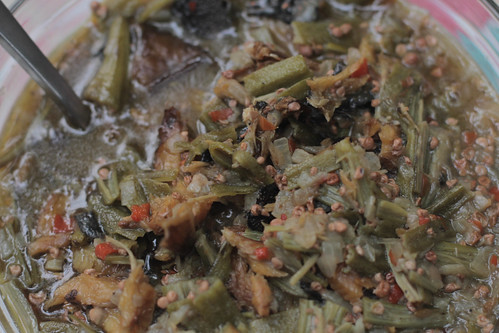Meal 62: Gabon
 New letter, new season, new home! After a week of unpacking our new place in Fort Greene - let's be honest, a lot of the work was setting up the kitchen! - we hopped right back into Noshing, which happened to be the first weekend of summer. We kicked off the G's with a meal from the west-central Francophone African country of Gabon, with the sultry weather giving us as good a taste of the tropics as we could have wanted.
New letter, new season, new home! After a week of unpacking our new place in Fort Greene - let's be honest, a lot of the work was setting up the kitchen! - we hopped right back into Noshing, which happened to be the first weekend of summer. We kicked off the G's with a meal from the west-central Francophone African country of Gabon, with the sultry weather giving us as good a taste of the tropics as we could have wanted.
The new kitchen is, on the whole, an improvement over the other. More storage and surface space, a fridge and stove that seem to lack any quirks, and it's directly adjacent to the back yard so there's natural light and fewer steps to the grill. The only bummer is that the stove is a mere 20 inches wide, making it impossible to have two pots side by side without propping one up on the edge. I'll manage
As far as the meal, regular readers and Noshers know that I try hard to pick out what's distinctive about a country's cuisine, which can be tough in Africa. The good news is I found a few, two of which use ground kernels. The not so good news is that the flavors were quite strange. At least the dessert was killer!
Joining us at this meal were Lisa, Anna, Kayla and Zoe (our hosts for the Comoros meal last year!), Alex and Catherine. Patrick and another Lisa showed up later.

Gâteau de ngondo | Melon seed dumpling | Recipe

The seeds of a particular type of melon are prized in area of the Gulf of Guinea, of which Gabon forms the southernmost shore. Rich in fat and protein, they're shelled and then ground, and usually added to stews as a thickener. But in the case of Gabon, I saw more than a few recipes for a sort of bread made of this flour, moistened and flavored by a court bouillon of onion, hot peppers, and smoked fish. Wrap in banana leaves (or in my case, foil), steam for an hour, and bake (or in my case, throw on the grill), slice, nibble, don't finish, throw out. The flavor was really offputtingly strong, a dense moist dumpling texture overpacked with aroma and flavor that just wasn't very appealing. Hope the other preparations of this seed flour turn out better!
Boeuf aux mangues sauvages | Beef stew with wild mango kernel | Recipe

I've heard wild mango kernel described as "Gabonese chocolate," so that would make this thick stew a "Gabonese mole." The wild mango is unrelated to but has fruit that tastes similar to the true mango, but the Africans take it a step further by scooping out the inside of the kernel. When mixed with red-palm-oil-simmered stew beef, the dish was richly but unsubtly flavored; it wasn't my jam but others at the table liked the creamy, rich, deep flavor.
Dongo-dongo | Okra stew with smoked fish | Recipe

The name of the famous Creole dish gumbo comes from the name that many African languages give to okra. This fun-to-say dish, which features gently simmered okra with smoked fish and seasonings, is considered a progenitor of the Louisiana classic. Despite okra's reputation for making sauces so goopy that many Peace Corps volunteers call food made from it "snot sauce," this preparation was really quite delicate and pleasant. The smoked fish, which appeared to be catfish, came with its tail rammed into its mouth in a sort of mockery of a Zen circle, and affixed with a thoroughly blackened skewer. It was an endeavor to remove the bones, but the effort was worthwhile as the whole stew was infused with a delicious flavor and studded with occasional nuggets of tasty, salty protein.
The meal was rounded out by starches: true yams (the drier, heavier, and not at all related analog to sweet potatoes which somehow are sometimes called yams anyway) and rice.
Bananes au four croustillantes | Crispy baked bananas | Recipe

Let's be honest, the dishes ranged from ok to downright weird, but there was no question that the dessert was a star. In my experience, Africa isn't big on dessert, at most you'd find cut fruit or a fried beignet (remember the nuns' farts from Chad?), so I jumped on the opportunity to make something that actually involved more than three ingredients -- turns out that the Gabonese retained a bit more of the French culinary influence than some other former colonies. The bananas are dipped in OJ and egg, dredged in breadcrumbs, lightly fried, and then baked until brown. (The recipe says to sprinkle with brown sugar afterward; I used turbinado sugar before so it would brown further.) With a dollop of sour cream (well, I used crème fraîche, figuring that's what the French would have introduced), it was just as good as you'd think.
It was a lovely evening in the new back yard, a long, slow summer sunset eventually giving way to some sprinkles of rain. We're on our way west now, look out for dispatches from meals in Washington and Oregon!